

Design Thinking: Dear Don . . . . . . this column is a response to your post of June 25th, titled, Design Thinking: A Useful Myth?
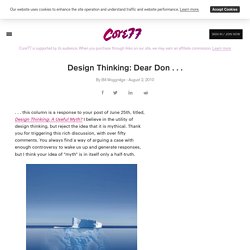
I believe in the utility of design thinking, but reject the idea that it is mythical. Thank you for triggering this rich discussion, with over fifty comments. Rethinking Design Thinking. The "Design Thinking" label is not a myth.
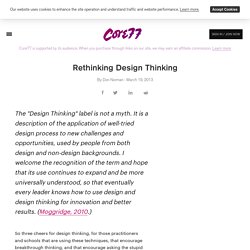
It is a description of the application of well-tried design process to new challenges and opportunities, used by people from both design and non-design backgrounds. I welcome the recognition of the term and hope that its use continues to expand and be more universally understood, so that eventually every leader knows how to use design and design thinking for innovation and better results. (Moggridge, 2010.) Which UX Deliverables Are Most Commonly Created and Shared? UX work happens in many different contexts, from very lean startups that employ Agile methodologies and embrace little documentation, to consulting engagements for third-party clients, all the way to large corporate or government environments with strict process and documentation requirements.
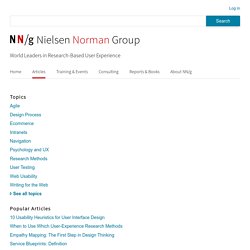
What unites these very different work environments is the need for UX professionals to communicate design ideas, research findings, and the context of projects to a range of audiences. Though we often communicate our work in conversation with others, deliverables help us document work for discussion, presentation, implementation, and later reference. Uxdesign. Uxplanet. Personas Persona is a fictional character created to represent a user type that might use a product in a similar way.
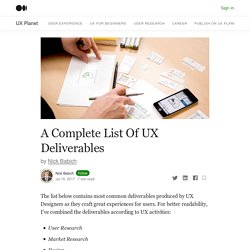
Personas make it easier for designers to create empathy with users throughout the design process. Related links: User Experience Deliverables. It’s an exhilarating time for the user experience community.
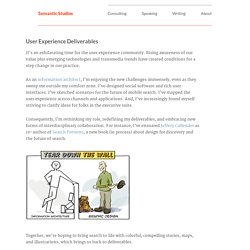
Rising awareness of our value plus emerging technologies and transmedia trends have created conditions for a step change in our practice. As an information architect, I’m enjoying the new challenges immensely, even as they sweep me outside my comfort zone. I’ve designed social software and rich user interfaces. PRODUCT EMOTION. Emotion is a central quality of human existence, and most of one’s behavior, motivation, and thought is enriched with and influenced by emotions.
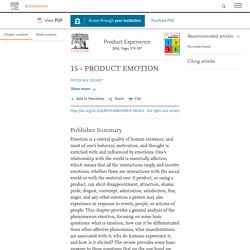
One’s relationship with the world is essentially affective, which means that all the interactions imply and involve emotions, whether these are interactions with the social world or with the material one. A product, or using a product, can elicit disappointment, attraction, shame, pride, disgust, contempt, admiration, satisfaction, fear, anger, and any other emotion a person may also experience in response to events, people, or actions of people. This chapter provides a general analysis of the phenomenon emotion, focusing on some basic questions: what is emotion, how can it be differentiated from other affective phenomena, what manifestations are associated with it, why do humans experience it, and how is it elicited?
What Puts the Design in Interaction Design. Why Should You Design?
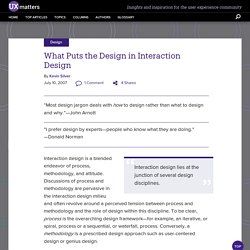
“I’ve been amazed at how often those outside the discipline of design assume that what designers do is decoration. Good design is problem solving.” —Jeffrey Veen. Home. Hci. Affordances en el diseño de objetos e interfaces - UX Research Blog. Uxdesign. There is no exact definition of what User Experience (UX) is, as this discipline is mainly about improving the experience and the way people interact with a given product.

UX design is often associated with User Interface (UI), and involves the construction of elements like navigation, ergonomics, usability and user path in a given interface (website, mobile app, video game, and even those ticket vending machines that drive me insane). In fact, UX covers a much wider range of fields including product design, economic systems, all kinds of services and by extension our everyday life.
As you can expect, it refers to several cognitive aspects when using a product or service, including functional and emotional expectations by placing the user (and not just the function) at the heart of the usage scenario. Youtube. (5) Creating Personas for User Experience Research. YouTube. Card Sorting 101 - Comprehensive Card Sorting Guide. You’ll explore your open and hybrid card sorting results to get ideas for labelling and grouping your information, so kick off your analysis with these questions in your head: What logic do participants follow in the categories they’ve created?

What cards do people put together in the same group all the time? What cards are never put together, and are thus considered conceptually different by all participants? Youtube. User Testing: Why & How (Jakob Nielsen) Interaction Design Foundation (IxDF) Paper prototyping is a process where design teams create paper representations of digital products to help them realize concepts and test designs.
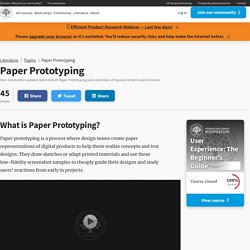
They draw sketches or adapt printed materials and use these low-fidelity screenshot samples to cheaply guide their designs and study users’ reactions from early in projects. See why paper prototyping is a small, yet invaluable investment. Youtube. Youtube. Las mejores herramientas para analizar el sentimiento de marca. Análisis de Secuencia: una herramienta para la Arquitectura de Información.
¿Cómo hacer un análisis UX? – Aula Creativa. Proceso Lean UX. Youtube. How To Do Card Sorting In UX Design (Video Guide) Diseño de Experiencia de Usuario UxD. Principios, procesos y herramientas UX para la enseñanza del Diseño. ¿Qué es la UX y la UI? Diseño de Experiencia de Usuario: etapas, actividades, técnicas y herramientas. How to Plan for Design (and Why) My new book is about planning for everything from websites to weddings.
My workshop and this article focus specifically on how to plan for design and how to explain why it matters. I realized that why and how are inseparable. We thought we’d closed the deal on a six figure, nine week project, when our client asked “what can you do in a week or two?” As the organization had recently shifted from waterfall to agile, he was under pressure to break the work into sprints. We explained an ability to “see the whole” is vital to information architecture, and then we reached agreement on a fast yet robust five week project. User Experience Design. I’ve been practicing information architecture since 1994, and from Gopher to Google have seen dramatic changes in the landscape of organization, search and retrieval.
Through these ten tempestuous years, I’ve found the infamous three circle diagram to be a great tool for explaining how and why we must strike a unique balance on each project between business goals and context, user needs and behavior, and content. Three Circles of Information Architecture While this diagram was conceived with IA in mind, it’s equally useful for explaining UX. In conjunction with Jesse’s masterpiece, I use the three circles to illustrate the distinction between user experience and user-centered design. I’m still not convinced UCD exists outside the realm of theory, but I practice user experience design every day. “UX” una palabra de moda. A la mayoría de la gente le resultaría…